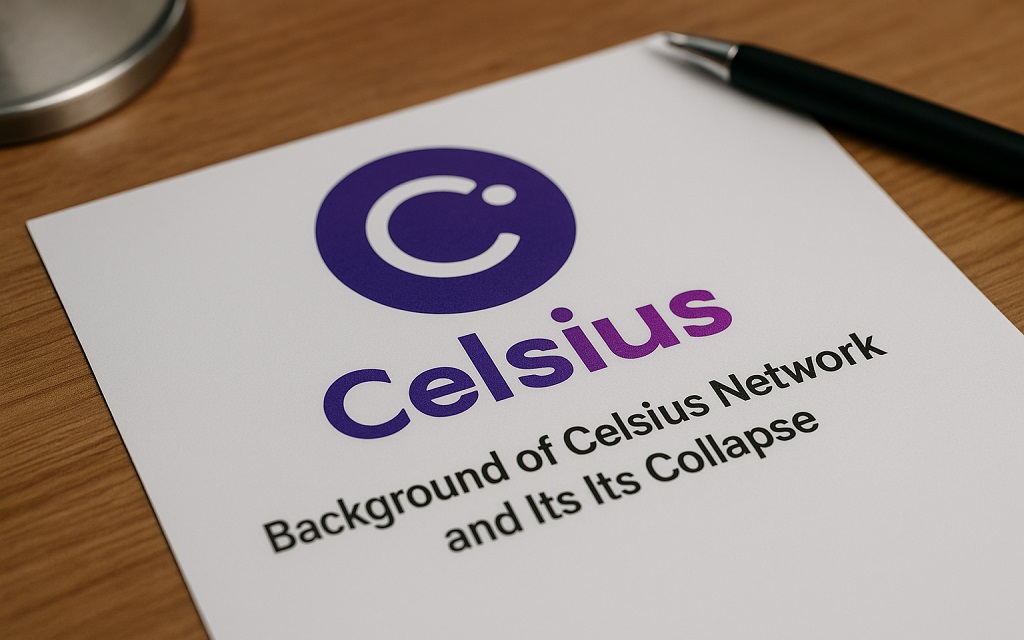The Celsius lawsuit has become one of the most critical cases in crypto history. It exposes how risky lending, unclear contracts, and poor transparency led to massive losses for investors. The case reached new headlines after Tether agreed to a $299.5 million settlement, ending years of dispute over billions in Bitcoin collateral. Creditors now look to this outcome for hope and recovery.
In addition to impacting previous platform users, the Celsius lawsuit establishes a crucial precedent for regulating digital assets. It marks a shift in responsibility in digital finance by demonstrating how courts now handle cryptocurrency disputes similarly to traditional financial matters.
What the Celsius Lawsuit Is About
Celsius Network once promised freedom from traditional finance. Its goal was simple. It offered interest for crypto deposits. It gave loans backed by digital coins. The company grew fast. Then the market fell.
In July 2022, Celsius filed for bankruptcy. Billions in customer assets vanished. Many users waited for answers. Courts opened lengthy investigations into what went wrong.
In 2025, one significant chapter closed. Stablecoin issuer Tether agreed to pay $299.5 million to settle a lawsuit tied to Celsius’s lost Bitcoin. The case centered on how Tether handled collateral before the bankruptcy.
The settlement followed months of legal battles. Celsius accused Tether of liquidating about 39,542 Bitcoin—worth over $4.5 billion—without proper notice. Tether denied wrongdoing. It said that as Bitcoin prices fell, Celsius was unable to post further collateral.
In July 2025, a federal judge allowed the case to proceed. After three months, both parties decided to put an end to the conflict. Tether paid the settlement to Celsius’s bankruptcy estate under the supervision of a recovery consortium.
This outcome marked a turning point for creditors. It showed that even powerful crypto firms can face accountability. It also signaled a shift in how courts view collateral disputes in digital finance.
Now, let’s look at how Celsius reached this point and what the settlement means for investors.
Background of Celsius Network and Its Collapse

Celsius Network began in 2017. Its founders promised a new path for finance. The platform claimed to help users earn yield on crypto assets. It paid high interest rates on deposits. It also allowed users to borrow cash against Bitcoin, Ethereum, and stablecoins.
The idea attracted millions. At its peak, Celsius managed more than $25 billion in assets. Its app became a primary name in decentralized finance. Users believed their funds were safe. They trusted the company’s promise of transparency and security.
Trouble grew inside the system. Celsius used customer funds for risky loans and trading. It lent assets to hedge funds without enough protection. When crypto prices fell in 2022, its balance sheet broke. Many loans went unpaid. Liquidity ran out fast.
By June 2022, users could no longer withdraw their money. Panic spread across the market. Celsius froze accounts to stop a complete collapse. Weeks later, it filed for Chapter 11 bankruptcy in New York.
Court records later showed that Celsius misused deposits. It also hid losses while claiming substantial profits. Regulators began to investigate. Reports from examiners confirmed a pattern of misleading behavior.
The fallout hit hard. Thousands of investors lost savings. Workers were laid off. Celsius’s own cryptocurrency, CEL, saw a sharp decline in value. Alex Mashinsky, the founder, quit shortly after.
Mashinsky was sentenced to 12 years in jail for fraud in May 2025. The court found he manipulated the CEL token and misused customer funds. He forfeited all rights to future bankruptcy claims.
Celsius’s bankruptcy left a trail of lawsuits. The most notable one came from its estate against Tether, a company once seen as its close partner. That dispute would later shape the largest settlement in Celsius’s recovery process.
Next, we explore how the conflict between Celsius and Tether started and why it became a defining moment in crypto law.
How the Dispute with Tether Began

Celsius and Tether once shared a close business link. Both companies operated within the same circle of digital finance. Celsius borrowed and lent assets through large over-the-counter transactions. Stablecoins from Tether were utilized as collateral in certain transactions.
Celsius started having problems at the beginning of 2022. The price of bitcoin fell precipitously. That drop triggered collateral calls under loan agreements. Celsius had pledged 39,542 Bitcoin to Tether as security for its borrowings. The contract required Celsius to post extra collateral when prices fell.
Tether claimed Celsius failed to meet that obligation. The stablecoin firm said it had every right to act. It liquidated the pledged Bitcoin to cover about $815 million in debt. Tether said it did so lawfully and even under Celsius’s direction.
Celsius saw the event differently. It said Tether moved too fast. Court filings later revealed a key detail. Celsius claimed the contract included a 10-hour window to add more collateral before liquidation. Tether, according to Celsius, ignored that rule and sold the Bitcoin early.
This became the heart of the dispute. Celsius said Tether’s actions erased its remaining stake in Bitcoin. The estate called it a violation of contract and fiduciary duty. It also accused Tether of breaching good-faith requirements under bankruptcy law.
In August 2024, Celsius’s estate filed an adversary proceeding in the U.S. Bankruptcy Court for the Southern District of New York. The suit sought recovery of roughly $4.5 billion worth of Bitcoin. Tether described the claim as a “baseless shakedown.”
Legal experts called the case significant. It raised a new question: how far can a lender go when digital assets back a loan? The issue tested the balance between contractual rights and fairness in crypto collateral management.
The dispute pushed Celsius’s recovery plan into deeper litigation. Yet, it also laid the foundation for a record settlement that changed the direction of the bankruptcy.
Next, we uncover the details of that settlement and what it means for creditors and the broader crypto market.
Inside the $299.5 Million Settlement
The ongoing dispute between Celsius and Tether came to an end in October 2025. The agreement was announced by a group called the Blockchain Recovery Investment Consortium (BRIC). BRIC includes GXD Labs and VanEck, two firms that specialize in distressed asset recovery.
Tether agreed to pay $299.5 million to settle all claims from the Celsius bankruptcy estate. The payment closed the adversary proceeding filed in August 2024. It also resolved related claims involving the disputed Bitcoin collateral.
The settlement was far smaller than Celsius’s demand. The estimated worth of the 39,542 Bitcoin at the center of the dispute was close to $4.5 billion, matching the amount the estate had requested. Even still, the estate clearly won with the $299.5 million award. It was immediate cash—something rare in crypto bankruptcies.
Court filings confirmed that the funds would flow to the Celsius estate for creditor distribution. BRIC said the outcome reflected “timely and efficient resolution.” The consortium called it proof that digital asset disputes could settle within the traditional legal system.
Tether’s public response was brief. CEO Paolo Ardoino said in a post on X that the company had resolved “all issues” tied to the Celsius case. He said Tether always acted within its contractual rights. This company stressed that no admission of liability was included in the agreement and denied any misconduct.
The payment also carried symbolic value. It showed that even top stablecoin issuers can face real consequences when disputes involve large sums of digital assets. The case highlighted how contracts in crypto must define clear collateral rules.
For Celsius creditors, the settlement created hope. It added a measurable boost to the estate’s recovery pool. The funds could help accelerate future distributions once approved under the bankruptcy plan.
The settlement also reinforced BRIC’s role as the primary recovery administrator for Celsius. Its task now includes managing other illiquid assets, pending litigation, and token recoveries.
Celsius Lawsuit Timeline of Key Legal Events
The Celsius lawsuit followed a transparent chain of actions. Each date marked a significant shift in the case.
| Date | Event | Key Details |
|---|---|---|
| July 2022 | Celsius bankruptcy filing | Celsius filed for Chapter 11 in New York. The move froze billions in user funds and started a court-supervised recovery. |
| Early 2023 | BRIC formed | The Blockchain Recovery Investment Consortium (GXD Labs + VanEck) launched to recover crypto assets from bankrupt firms. |
| January 2024 | BRIC appointed | The court named BRIC as Celsius’s asset recovery and litigation administrator. It began tracking hidden or illiquid holdings. |
| August 2024 | Lawsuit against Tether filed. | Celsius estate filed an adversary proceeding in the SDNY Bankruptcy Court. It accused Tether of liquidating 39,542 Bitcoin without notice. |
| February 2025 | Tether motion to dismiss | Tether argued that liquidation followed contract rules and market protocols. It denied any breach of the agreement. |
| July 2025 | Court ruling on dismissal | The judge denied most of Tether’s motion. Celsius’s claims for breach of contract and bad faith were allowed to proceed. |
| October 2025 | Settlement announced | Tether paid $299.5 million to the Celsius estate. The deal ended the lawsuit and closed all related claims. |
Each entry marked real progress. The lawsuit evolved from crisis to closure. The July ruling gave Celsius leverage. The October settlement turned that leverage into money for creditors.
Now, we explain how BRIC and VanEck guided Celsius through the recovery process and what their leadership means for future crypto bankruptcies.
Role of BRIC and VanEck in Recovery

The Blockchain Recovery Investment Consortium (BRIC) became the driving force behind Celsius’s asset recovery. The group formed in 2023 as crypto bankruptcies piled up across the market. It joined two major firms—GXD Labs and VanEck. Their goal was clear. They aimed to locate, recover, and manage digital assets trapped in failed companies.
When Celsius’s bankruptcy estate searched for professional management, BRIC stepped in. The court approved its appointment in January 2024. The decision gave BRIC complete control over litigation, settlements, and the pursuit of lost value.
BRIC built its recovery plan around three pillars.
- Litigation Supervision: The team oversaw legal actions against organizations that owed money or had assets connected to Celsius.
- Asset Valuation: The process identifies loans, illiquid tokens, and tangible assets that might be sold in the future.
- Creditor Returns: It focused on maximizing payout timelines under court supervision.
VanEck brought institutional weight. Known for its asset management background, VanEck provided financial modeling, risk evaluation, and distribution strategy. Its experience in traditional finance helped bridge the gap between crypto procedures and bankruptcy law.
GXD Labs handled the technical work. The firm traced on-chain transactions, verified digital wallets, and managed crypto liquidation strategies. Its data analytics helped confirm values for assets spread across exchanges and custodians.
Together, BRIC and VanEck built a structure that courts could trust. Their combined effort gave Celsius creditors a stronger path to real recovery.
The $299.5 million settlement with Tether proved that the strategy worked. BRIC’s lawyers and analysts pushed for a resolution rather than the risk of a prolonged trial. The result brought instant liquidity into the Celsius estate and reduced further legal expense.
The consortium’s work now continues. It manages residual assets, token sales, and pending claims against other third parties. Its leadership in the Celsius case may serve as a template for recoveries from cryptocurrency bankruptcy in the future.
Court Decisions and Legal Impacts
Several significant decisions shaped the Celsius lawsuit against Tether. Every court ruling established the parameters of the arguments that each side might make and influenced the course of the case.
The first significant decision was rendered in February 2025. Tether filed a motion to dismiss all claims. It argued that Celsius failed to meet margin calls and that liquidation followed contract terms. The defense said Celsius had agreed to allow Tether to sell Bitcoin once collateral thresholds were breached.
After reviewing the evidence, the court discovered several contested facts. Celsius had made a credible claim, according to Judge Martin Glenn. He allowed key counts—breach of contract and breach of good faith—to move forward. This ruling kept the case alive. It also gave Celsius a stronger position in settlement talks.
In his opinion, the judge highlighted the 10-hour collateral window. He said Celsius could proceed to prove that Tether failed to follow this clause. That detail became the center of discovery. It showed how written agreements in crypto lending can create legal risk when terms lack clarity.
In July 2025, a further court judgment upheld such conclusions. Once more, the judge set deadlines for document submission and denied dismissal on the majority of counts. That decision placed pressure on Tether to negotiate. Discovery would have required internal trading records, communication logs, and price data.
Legal observers viewed the ruling as a warning for the entire crypto industry. Courts were now treating digital-asset contracts like traditional financial instruments. The ruling also made it clear that when disagreements emerge, lenders cannot hide behind volatility.
Both parties agreed following months of private talks. The case ended before trial when a settlement was reached in October 2025. The court approved the payment structure soon after.
The sequence of rulings confirmed that crypto contracts fall under the same legal standards as any commercial agreement. The outcome set a precedent for how future digital lending disputes may be judged.
Next, we look at how the settlement affects creditors and investors still waiting for payouts from the Celsius bankruptcy estate.
Impact on Creditors and Investors
The $299.5 million settlement gave Celsius creditors a clear gain. It added real money to the estate’s recovery pool and increased confidence among claim holders. Every payout in a bankruptcy depends on available assets. This settlement raised the total.
Creditors saw hope after years of uncertainty. The estate had already liquidated some crypto holdings, but much of the value remained tied to lawsuits. The Tether deal unlocked immediate liquidity. That money will now support future distributions under the confirmed bankruptcy plan.
The recovery plan divides creditors into categories.
- Custody Account Holders: Users who stored assets but did not earn interest may receive priority treatment.
- Earn Account Holders: Users who accepted yield offers face longer processing times because they are classified as unsecured creditors.
- Loan and Collateral Claimants: Those with loans backed by crypto assets fall under specialized settlement procedures.
BRIC will oversee how funds are distributed. Its role includes verifying claims, adjusting for asset values, and transferring payments when court approvals are complete. The process will move through standard bankruptcy channels—claim validation, plan confirmation, and distribution.
For retail investors, this settlement carries symbolic weight. It shows that large crypto creditors can win partial recoveries through structured legal action. The result encourages more investors to file proper proofs of claim rather than abandon their cases.
The payment also gives regulators and courts a model for future settlements in digital finance. It balances fairness and practicality. Celsius did not recover the full $4.5 billion it sought, yet it secured a fast, verified payout. That matters more in bankruptcies, where time erodes value.
The added funds may also shorten the wind-down phase. As remaining claims close, the estate can move toward final distribution sooner. That outcome will finally bring closure to thousands of users who lost their savings during Celsius’s collapse.
How the Celsius Lawsuit Shapes Crypto Law

The Celsius lawsuit changed how courts view digital assets. It proved that crypto contracts face the same legal scrutiny as any financial deal. Judges no longer see tokens or digital collateral as gray areas. They treat them as property governed by law.
The case also forced lenders to rethink how they manage collateral. Celsius argued that Tether moved too fast when liquidating Bitcoin. The court’s reaction showed that speed does not excuse broken contracts. When a clause promises a time window, it must be honored. That single point reshaped expectations for digital lending.
Another impact came from the judge’s use of the Howey Test. This test helps courts decide if an asset acts like a security. The Celsius proceedings showed that yield products and loan agreements can meet that standard. Platforms that promise returns now face heavier compliance pressure.
Regulators followed the case closely. The Securities and Exchange Commission (SEC) and the Commodity Futures Trading Commission (CFTC) have cited Celsius as an example of how crypto lenders blur the line between investment and deposit. The outcome supports more oversight of interest-bearing crypto accounts.
For investors, the message is simple. Crypto lending carries legal and financial risk. When companies collapse, user funds become part of complex bankruptcy structures. The Celsius case reminds users to read terms carefully and understand what “ownership” means in digital custody.
The lawsuit also influenced how stablecoin issuers behave. Tether’s decision to settle showed that even the most prominent firms will compromise to avoid deeper litigation. That precedent could push other crypto institutions to settle faster rather than fight lengthy court battles.
Legal scholars call this case a milestone. It blends traditional finance law with blockchain reality. It also introduces a framework for future disputes over digital collateral, yield products, and token-based lending.
Though its legal aftermath brought new clarity, Celsius’s fall may have eroded trust. Stronger regulations, more transparent contracts, and more stringent oversight are now in place in the sector.
FAQs
What is the Celsius lawsuit?
Before filing for bankruptcy, Tether’s handling of Bitcoin collateral was the focus of the Celsius litigation. Celsius asserted that Tether violated a contract provision allowing for a 10-hour window for additional collateral and sold 39,542 Bitcoin prematurely.
In a Celsius lawsuit, how much money can I expect to receive?
Payouts depend on your claim type, but most creditors will receive a partial recovery from the estate’s available funds, including the $299.5 million Tether settlement.
What is the settlement for Celsius?
In 2025, Tether settled a lawsuit over the liquidation of about 39,542 Bitcoin by paying $299.5 million to the Celsius bankruptcy estate.
Why didn’t Celsius work?
After leveraging consumer money for reckless loans and trading that couldn’t withstand the 2022 crypto market meltdown, Celsius fell apart.
Final Takeaway
The Celsius lawsuit stands as a warning and a guide. It exposed how fragile trust becomes when digital finance forgets discipline. The company once promised freedom from banks. Instead, it collapsed under its own risk.
The $299.5 million Tether settlement provided creditors with tangible results after years of uncertainty. It proved that recovery in crypto bankruptcies is possible through structured legal action. It also showed that courts can enforce fairness even in unregulated digital markets.
For investors, this case delivers a simple message. Contracts matter. Rules matter. When platforms offer yield or loans, every clause shapes what happens when prices crash. Celsius’s downfall shows that unverified promises can destroy entire savings.
For the industry, the case defines a shift. Lenders, exchanges, and stablecoin issuers now operate under closer legal and regulatory eyes. The lawsuit set a precedent for how crypto contracts are enforced. The Howey Test now applies more clearly to digital yield products. Regulators will use this case to demand stronger compliance from crypto firms.
Celsius will remain a case study in law and finance. Its rise and fall captured how fast innovation can turn into litigation. Yet, its resolution brings structure to a space once ruled by chaos.
Creditors will finally see part of their funds return. Tether avoided a deeper trial but paid a cost that echoes through the industry. BRIC’s success in managing this case may become a model for future crypto recoveries.
The Celsius story is not only about loss. It is about legal order taking shape around digital assets. The outcome gives investors, lawyers, and regulators a shared truth—crypto must now follow the same rules as every financial system built on trust and accountability.
Disclaimer: This article provides a general overview of the Celsius lawsuit, based on publicly available information, and is intended for informational purposes only. It is not legal advice.


![Read more about the article Isotonix Lawsuit: What You Need to Know About Legal Allegations [2025 Update]](https://www.judicialocean.com/wp-content/uploads/2025/02/Isotonix-lawsuit-768x480.jpg)

